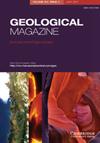化学风化对巴西白垩纪克拉托组矿化昆虫异常保存的影响:对细粒Lagerstätten矿床晚成岩作用的影响
IF 2
3区 地球科学
Q3 GEOSCIENCES, MULTIDISCIPLINARY
引用次数: 0
摘要
许多研究提高了我们对克拉托化石Lagerstätte保存模式的认识。克拉托矿化昆虫的高度保存被认为是离子通过尸体扩散和细菌包裹的结果,而细菌扩散又创造了导致矿化的微环境条件,主要是黄铁矿化。第四纪黄铁矿化昆虫在原位风化作用下被氧化为更稳定的氧化/羟基矿物。这种转化对于维持氧化环境中微生物诱导的黄铁矿化过程中获得的古生物学信息至关重要。然而,强烈的风化作用会降低或模糊这些化石的形态保真度,因此对这些化石所经历的后成岩过程的关注很少。在这里,我们的目的是通过以下分析工具的组合:扫描电镜,能量色散x射线光谱,傅里叶变换红外和拉曼光谱来确定克拉托黄铁矿化昆虫的蚀变程度。我们的研究结果表明,保存较好的昆虫优先被赤铁矿取代,保存较差的化石被针铁矿取代。此外,我们还记录了三种类型的成岩后改变:氧化铁过度生长的昆虫;昆虫与黑色涂层有关,有时形成树突;昆虫作为一个印象被保存下来,那里只留下了身体的轮廓。所有这些变化都有可能扭曲或玷污古生物学信息。在这里,我们在宏观和微观尺度上测量了这种远成岩改变的影响。因此,这种地形学方法在任何含有矿化昆虫的细粒矿床中都具有广泛的适用性。本文章由计算机程序翻译,如有差异,请以英文原文为准。
Effects of chemical weathering on the exceptional preservation of mineralized insects from the Crato Formation, Cretaceous of Brazil: implications for late diagenesis of fine-grained Lagerstätten deposits
Abstract Many studies have improved our understanding of the mode of preservation at the Crato fossil Lagerstätte. The high degree of preservation of the Crato mineralized insects is thought to be a consequence of the diffusion of ions through carcasses and envelopment by bacteria that, in turn, created microenvironmental conditions that led to mineralization, mainly pyritization. Pyritized insects have been oxidized by in situ weathering to more stable oxide/hydroxy minerals during Quaternary time. This transformation is essential to maintain the palaeontological information acquired during microbially induced pyritization in an oxidizing atmosphere. However, intense weathering can diminish or obscure the morphological fidelity, and little attention has been paid to the post-diagenetic processes experienced by these fossils. Here, we aim to determine the degree of alteration undergone by Crato pyritized insects using the following combination of analytical tools: scanning electron microscopy, energy dispersive X-ray spectroscopy, Fourier transform infrared and Raman spectroscopy. Our results show that well-preserved insects are preferentially replaced by haematite and poorly preserved fossils are replaced by goethite. In addition, we recorded three types of post-diagenetic alteration: insects with iron-oxide overgrowths; insects associated with black coatings, sometimes with the formation of dendrites; and insects preserved as an impression, where only the outline of the body remains. All of these alterations have the potential to distort or tarnish palaeontological information. Here, we measured the effects of such telodiagenetic alterations at macro and micro scales. Therefore, this taphonomic approach has wide applicability wherever fine-grained deposits bearing mineralized insects are found.
求助全文
通过发布文献求助,成功后即可免费获取论文全文。
去求助
来源期刊

Geological Magazine
地学-地球科学综合
CiteScore
4.70
自引率
0.00%
发文量
111
审稿时长
3 months
期刊介绍:
Geological Magazine, established in 1864, is one of the oldest and best-known periodicals in earth sciences. It publishes original scientific papers covering the complete spectrum of geological topics, with high quality illustrations. Its worldwide circulation and high production values, combined with Rapid Communications and Book Review sections keep the journal at the forefront of the field.
This journal is included in the Cambridge Journals open access initiative, Cambridge Open Option.
 求助内容:
求助内容: 应助结果提醒方式:
应助结果提醒方式:


